 Elaborate Bao Xiang Hua, Jiaqing (Christies)
Elaborate Bao Xiang Hua, Jiaqing (Christies)
Many years ago I was corrected when describing the pattern on a C20th porcelain Chinese jar as a ‘Lotus Scroll’. This decorative element of a ‘flower with leaf flourish and scrolls’, is actually known as ‘Bao Xiang Hua’ (below).
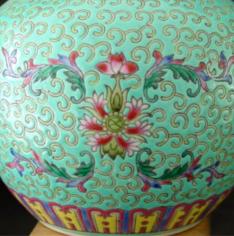 Bao Xiang Hua, ‘flower’, leaf flourish and scrolls, People’s Republic of China, 1950s
Bao Xiang Hua, ‘flower’, leaf flourish and scrolls, People’s Republic of China, 1950s
In the West, this is usually described as a Lotus Scroll, in some instances even a peony scroll. Don’t get me wrong, there are examples of Lotus scrolls which really are lotuses, and there are countless examples of true peony scrolls (below).
 Yuan Peony Scroll, Adam’s, Dublin
Yuan Peony Scroll, Adam’s, Dublin
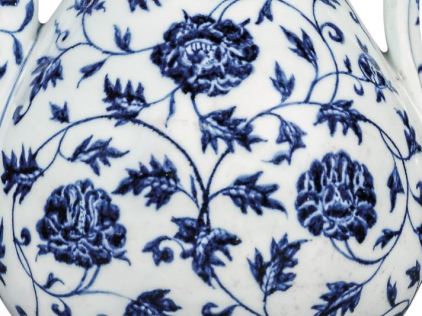 Yongle Peony Scroll, Christies
Yongle Peony Scroll, Christies
Descriptions in design books recognise that the leaves of this ‘lotus’ (see picture below) are not the natural shape of large rounded and dissected leaves emerging from a body of water, but are composed of scrolling tendrils and leaves which are more like an acanthus leaf flourish from ancient Greek art. They offer no explanation for this dichotomy – they do not seem to question that the ‘Lotus’ flower in question doesn’t actually look much like a lotus any way! Below is a picture of a ‘Bao Xiang Hua’ on a Xuande blue & white vessel, often and even to the present day described in the West as a ‘Lotus Scroll’, even in the biggest auction houses:
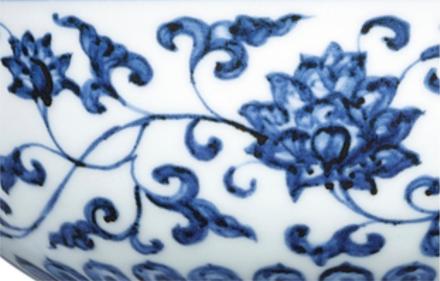 Bao Xiang Hua on Xuande porcelain (Sotheby’s)
Bao Xiang Hua on Xuande porcelain (Sotheby’s)
The ‘Lotus Scroll’ is often not a lotus at all – it is a ‘Bao Xiang Hua’
So what is the Bao Xiang Hua?
Bao 宝 = Treasure or Precious Thing
Xiang 相 = Verb: physiognamize (showing appearance of someone’s face); Noun: looks, appearance; Adverb: mutually, together, jointly, successively
Hua 花 = Flower
It is actually quite difficult to find an answer in the English language internet realm. No amount of searching gave a better description than one of my reports from 2013 where I quoted Kh Chan from Malaysia who explained to me many years ago that: “Hua is flower in chinese and Bao Xiang is the respectful word used by Buddhists to address the portrait of Buddha. It is an imaginary flower which accompanies the spreading of the religion in Wei and Jin Dynasty.”
Book searches turned up this explanation from Patricia Bjaaland Welch: “an imaginary composite flower that was very popular during the Sui and Tang Dynasties, which was meant to represent ‘majesty and beauty’…. This purely decorative flower combines the attributes of the peony, lotus, chrysanthemum, pomegranate, and other diverse flowers…. It has also been called Buddha’s rose” From, Chinese Art, A Guide to Motifs and Visual Imagery 2008 ISBN-10: 0-8048-3864-X ISBN13: 978-08048-3864-1 Patricia Bjaaland Welch, Tuttle Publishing
For me, I just wanted to know more about this, how and why this ‘flower’ came about and what the relationship to Buddha and Buddhism is. The reason: it occurs on so much Chinese porcelain! This Bao Xiang Hua element is so common in Chinese Art through the centuries, I couldn’t understand why it was so hard to find out about.
And that’s where the ‘Hosoge’ comes in! Hosoge is the Japanese word for the Bao Xiang Hua. It has obviously been studied by western scholars, in particular reference to Buddhist sutra covers and all manner of Japanese decorative arts. Although I believe the ‘Hosoge’ refers to perhaps a greater range of decorative, stylised ‘flowers’ plus tendrils or scrolls than the Bao Xiang Hua that I am familiar with, it is definitely where I have found some of the answers I am looking for – and it really adds to my appreciation of Chinese porcelain which has this pattern.
So, I was reading about a collection of Japanese paintings and calligraphic works in ‘Brush & Ink’ – The Heinz Gotze Collection, Edited by Gisela Armbruster and Helmut Brinker, published by Paragon Book Gallery, NY, 1976. Here, in a description of a Heian Scroll (end of C12th) depicting The Great Sutra of Perfect Wisdom, on blue paper and decorated in gold and silver inks, see below!
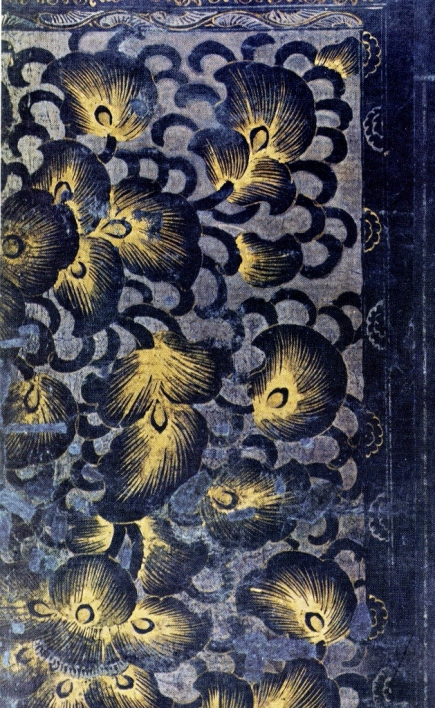 Hosoge or Bao Xiang Hua on the outer cover of a C12th Sutra scroll originally from the Jingoji Temple in Kyoto, Japan
Hosoge or Bao Xiang Hua on the outer cover of a C12th Sutra scroll originally from the Jingoji Temple in Kyoto, Japan
The outer cover sheet of these sutra scrolls is called the ‘hyoshi’ and by tradition it is lavishly decorated with hosoge, or Bao Xiang Hua – from the book:
“ (Chin. Pao-hsiang-hua) [Bao Xiang Hua] an ornament of great importance within the conventions of Buddist art in China and Japan. These ‘flowers of the precious appearance’ are often referred to in a misleading simplification as ‘lotus-blossom pattern’….
…What is certain is that the hosoge flower design came into use in Chinese ornamentation of the T’ang Period, apparently in the eighth century, in the form of decorative rosettes, which accounts for its being equated with the lotus blossom. The motif probably had its origin in Serindia, where an Indian rose, whose blooms resemble a large multipetalled wild rose (Rosa Chinensis Sieb.), seems to have been revered as the ‘flower of Buddha’s countenance’ (my emphasis). This also explains the name pao-hsiang-hua or hosoge, the precious appearance being that of Buddha’s countenance. The genuine hosoge ornament includes foliage of an opulence matching that of the flower, indicating an origin in T’ang ornamentation but revealing an imaginative further development by Japanese artists.” (pp12,13)
The motif seems to have been revered as the ‘flower of Buddha’s countenance’
Further searches came up with this beautiful mixed metal silver and gold flower basket with hosoge floral arabesque design in openwork, Nanbokucho period, 14th century, a National Treasure piece in the Tokyo Museum:
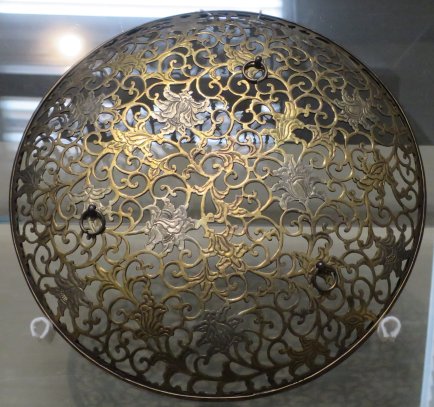 In some Buddhist ritual services, priests scatter flower petals made of paper. Keko are baskets to hold these ritual paper petals. Engraved openwork designs of hosoge flowers and vines grow out from the centre of this basket in three different directions and across the entire surface.
In some Buddhist ritual services, priests scatter flower petals made of paper. Keko are baskets to hold these ritual paper petals. Engraved openwork designs of hosoge flowers and vines grow out from the centre of this basket in three different directions and across the entire surface.
One can see immediately the likeness of the Hosoge/Bao Xiang Hua pattern above, in metal, to the blue & white Ming Dynasty versions on Chinese porcelains as shown at the beginning of this report (and more below!).
So, now it is a great pleasure to show more examples of this wondrous floral element on Chinese porcelains through time, knowing that its original meaning was quite religious. I am not sure how many people know of its significance and relationship to the face of Buddha these days! If I could read Chinese, it should be easy to find out! However, a quick internet search does show similar results, but with less attention to the Buddhism and countenance aspect and a concentration of the separate floral and other elements which make up the ‘Bao Xiang Hua’. One commentator notes:
“The treasures of the Tang Dynasty combine the characteristics of many flowers such as peony, camellia, and pomegranate, and the decorative techniques are more gorgeous. In the Ming Dynasty, Bao Xianghua became simple and lost its symbolic meaning. It often appeared in various types of porcelain in combination with flower patterns such as tangled lotus… Baoxianghua is an ideal flower shape with holiness, dignity and beauty. It is accompanied by the popular patterns popular in Chinese Buddhism. It combines the characteristics of lotus, peony and chrysanthemum, and combines patterns with artistic treatment…. Bao Xiang: It is the Buddhist respect for Buddha statues”. https://www.sohu.com/a/314213751_99940915 人间无此花 瓷上展娇姿(人造花之宝相花
BAO XIANG HUA EXAMPLES – MING DYNASTY
 Yongle, Sotheby’s
Yongle, Sotheby’s
 Yongle, Sotheby’s
Yongle, Sotheby’s
 Xuande, Sotheby’s
Xuande, Sotheby’s
 Xuande, Art Gallery of NSW
Xuande, Art Gallery of NSW
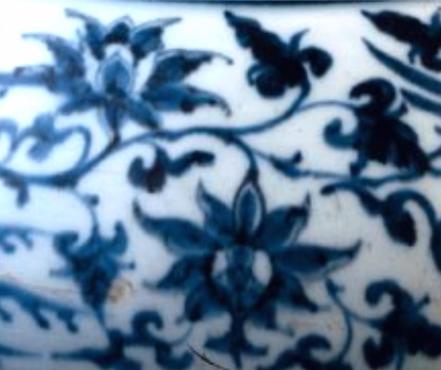 Yuan Dynasty, British Museum
Yuan Dynasty, British Museum
 Yuan Dynasty, Metropolitan Museum
Yuan Dynasty, Metropolitan Museum
BAO XIANG HUA EXAMPLES – EARLY QING DYNASTY
 Kangxi, Christies
Kangxi, Christies
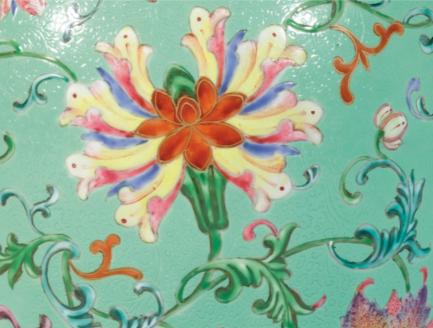 Qianlong, Sotheby’s, rare asymmetry in the surrounding leaf flourishes
Qianlong, Sotheby’s, rare asymmetry in the surrounding leaf flourishes
 Qianlong, Sotheby’s
Qianlong, Sotheby’s
 Qianlong, Sotheby’s
Qianlong, Sotheby’s
 Qianlong, Sotheby’s
Qianlong, Sotheby’s
 Qianlong, Sotheby’s
Qianlong, Sotheby’s
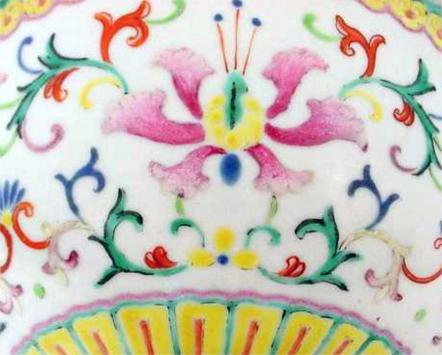 Qianlong minyao bowl
Qianlong minyao bowl
 Qianlong/Jiaqing, Christies
Qianlong/Jiaqing, Christies
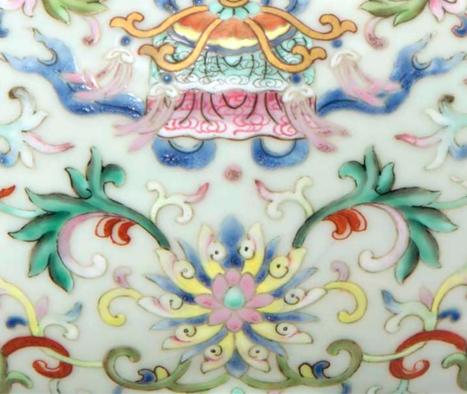 Jiaqing, Christies
Jiaqing, Christies
 Jiaqing, Christies
Jiaqing, Christies
 Jiaqing, Christies
Jiaqing, Christies
 Jiaqing, Christies
Jiaqing, Christies
 Jiaqing, Sotheby’s
Jiaqing, Sotheby’s
 Jiaqing, Sotheby’s
Jiaqing, Sotheby’s
 Jiaqing, Sotheby’s
Jiaqing, Sotheby’s
 Jiaqing, Sotheby’s
Jiaqing, Sotheby’s
 Jiaqing, Sotheby’s
Jiaqing, Sotheby’s
 Daoguang, Christies
Daoguang, Christies
 Daoguang, Christies
Daoguang, Christies
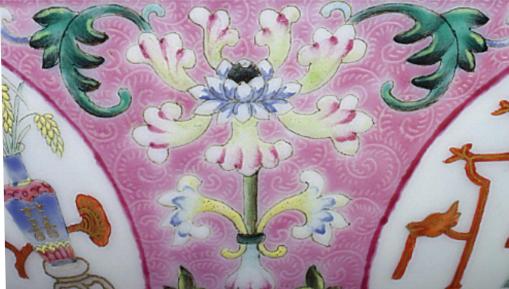 Daoguang, Christies
Daoguang, Christies
 Daoguang, Christies
Daoguang, Christies
 Daoguang, Christies
Daoguang, Christies
 19th century version
19th century version
 19th century version
19th century version
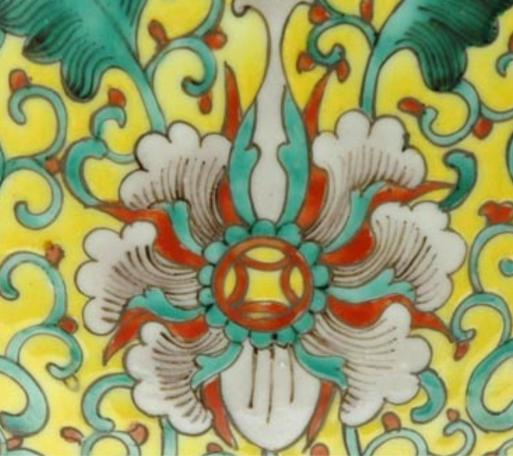 19th century version
19th century version
BAO XIANG HUA EXAMPLES – LATE QING DYNASTY
 Tongzhi, Sotheby’s
Tongzhi, Sotheby’s
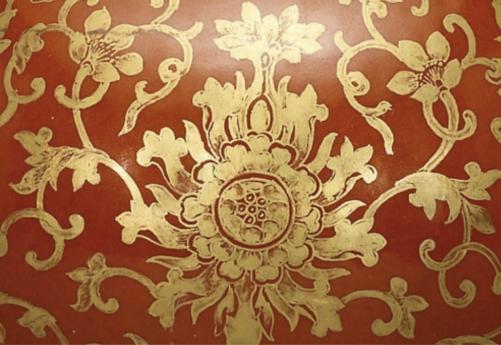 Xianfeng, Christies
Xianfeng, Christies
 19th Century Canton vase
19th Century Canton vase
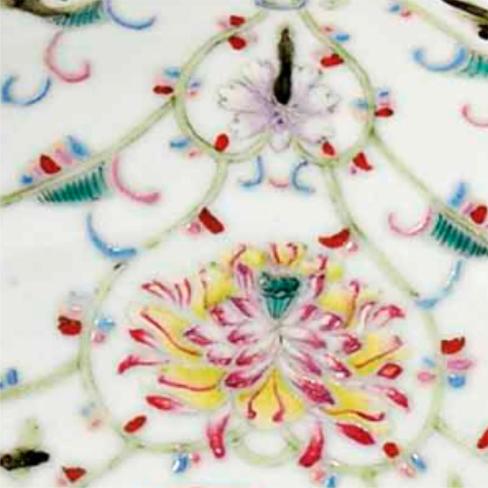 Guangxu, Christies
Guangxu, Christies
 Guangxu, Doucai Enamels on Blue & White
Guangxu, Doucai Enamels on Blue & White
 Guangxu lidded tureen
Guangxu lidded tureen
BAO XIANG HUA EXAMPLES – REPUBLIC PERIOD
 Republic vase, Christies
Republic vase, Christies
 Republic Vase border
Republic Vase border
 Republic vase border, Christies
Republic vase border, Christies
 Republic ginger jar
Republic ginger jar
 20th Century vase border, Christies
20th Century vase border, Christies
 Republic bowl
Republic bowl
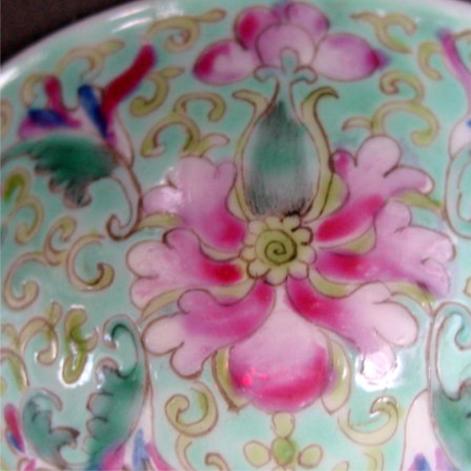 Republic bowl
Republic bowl
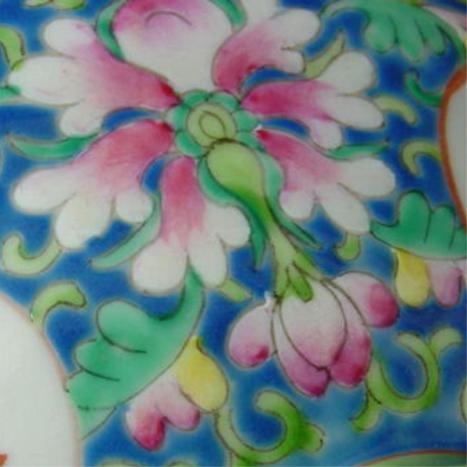 Republic serving bowl lid
Republic serving bowl lid
 Republic tea bowl
Republic tea bowl
 Republic serving bowl
Republic serving bowl
 Republic molded enamel plate
Republic molded enamel plate
 Republic Period plaque border
Republic Period plaque border
BAO XIANG HUA EXAMPLES – PROC (People’s Republic of China) PERIOD
 Mid C20th tea bowl
Mid C20th tea bowl
 Mid C20th tea bowl
Mid C20th tea bowl
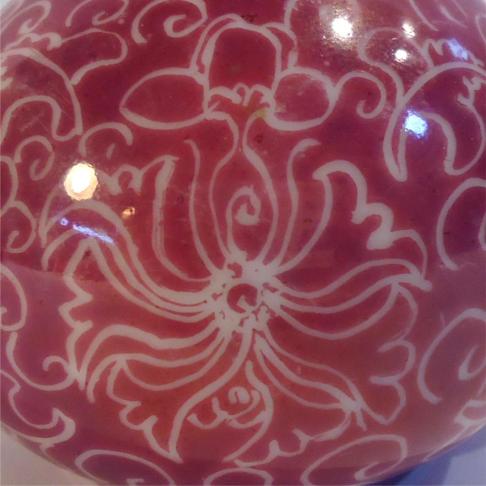 Mid C20th tea pot, sgraffito Bao Xiang Hua
Mid C20th tea pot, sgraffito Bao Xiang Hua
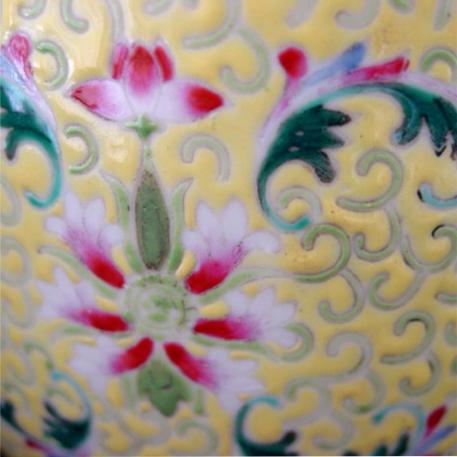 1960s/70s vase
1960s/70s vase
 PROC dish, with metal surround
PROC dish, with metal surround
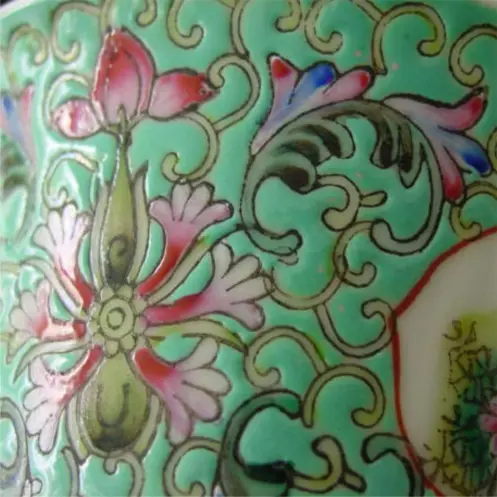 PROC teabowl, note the many stamped then infilled elements.
PROC teabowl, note the many stamped then infilled elements.
There are so many interesting details in each of these Bao Xiang Hua elements through the centuries. I am glad I now know more about the symbolism and sincerely hope that you are now more informed as well.
Michaela Russell Sydney, September, 2019
List of reports on this blog:
- Contemplating Buddha’s countenance – the Bao Xiang Hua 宝相花 (aka Hosoge or ‘Lotus or Peony Scroll’) in Qing and C20th Chinese porcelain
- ‘Flower Balls’ on C19th and C20th Chinese porcelain (花球 Huā qiú)
- JIANGXI PORCELAIN COMPANY(江西瓷业公司) – Part 1 – The Early Years (一开始)
- Best 10 books for the Chinese Republic period (1912-1949)
- Chinese porcelain LIDDED SERVING BOWLS – a 20th Century shape
- Dated 20th Century Chinese Porcelain Compilation: 1900 to 2000
- The Ogee Cartouche on Chinese Republic Porcelains (民国瓷反弧开光)
- Deconstructing the ‘Rice Grain’ Pattern on Chinese Porcelain – Late Qing to PRC
- Wang Bu’s Chrysanthemum Legacy (王步菊花遗产)
- Green press-moulded wares, Republic of China (& earlier)
- Chinese Republic porcelain, Shanghai marked landscape examples (民国瓷上海)
- JIUJIANG PORCELAIN COMPANIES IN THE CHINESE REPUBLIC ERA 九江瓷民国
- A CENTIFLEUR TEA PARTY
- 10 Chinese Millefleur Teabowls (中国十大米尔芙蓉茶碗)
- The Puce Landscape Pattern on Porcelain – Chinese Republic Era Stereotype
- Chinese Lions in the 19th and 20th centuries
- Dayazhai (大雅齋) Porcelains: A Brief Outline
- CHINESE REPUBLIC (1912-1949) and other MARKS OVERVIEW
- Some notes on Wan Shou Wu Jiang (万寿无疆) Porcelains since the Late Qing period
Thanks, very nice, I love that pattern! Have a nice day Cristina
Envoyé de mon iPhone
>
Thank you Michaela, this is so kind to make this information available. P
Hello Michaela, thank you for all the interesting and extensive articles on the republic period. I am patiently looking forward to many more. I have a underglaze blue and white and also red plaque dated to the sixth year of the republic making it 1917. I think the interesting part of the ceramic plaque is that it appears to be both hand painted and transfer printed and if so would make this an early example of a transfer printed ware. Are you by chance interested in a copy of the image for your collection?
Thank you for your comments and kind words! I will contact you privately regarding your plaque.